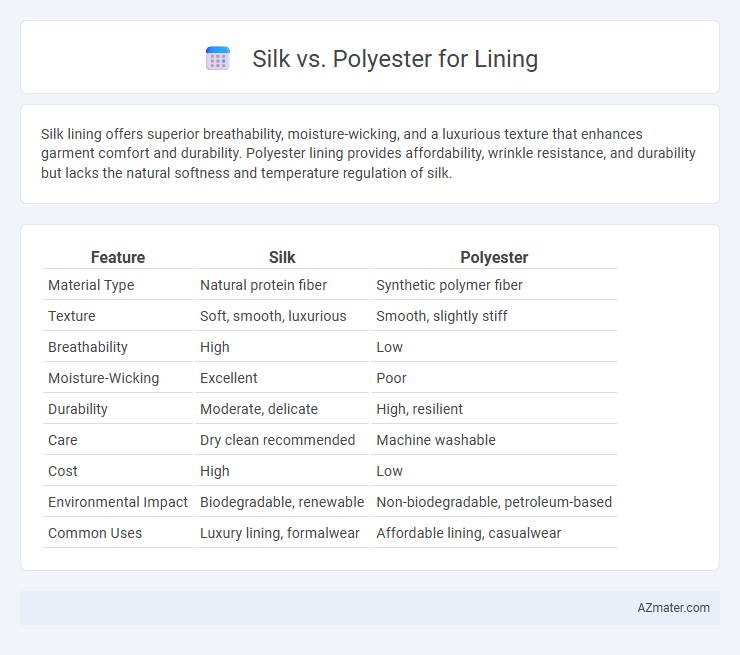Silk lining offers superior breathability, moisture-wicking, and a luxurious texture that enhances garment comfort and durability. Polyester lining provides affordability, wrinkle resistance, and durability but lacks the natural softness and temperature regulation of silk.
Table of Comparison
| Feature | Silk | Polyester |
|---|---|---|
| Material Type | Natural protein fiber | Synthetic polymer fiber |
| Texture | Soft, smooth, luxurious | Smooth, slightly stiff |
| Breathability | High | Low |
| Moisture-Wicking | Excellent | Poor |
| Durability | Moderate, delicate | High, resilient |
| Care | Dry clean recommended | Machine washable |
| Cost | High | Low |
| Environmental Impact | Biodegradable, renewable | Non-biodegradable, petroleum-based |
| Common Uses | Luxury lining, formalwear | Affordable lining, casualwear |
Introduction to Fabric Linings
Silk linings offer exceptional breathability and a luxurious feel, making them ideal for high-end garments requiring smooth texture and natural moisture-wicking properties. Polyester linings provide durability, wrinkle resistance, and cost-effectiveness, often chosen for everyday wear and easy care. Fabric lining selection impacts garment comfort, longevity, and overall garment performance based on fiber characteristics and end-use requirements.
What is Silk Lining?
Silk lining is a natural, luxurious fabric made from the fibers produced by silkworms, prized for its smooth texture, breathability, and moisture-wicking properties. Unlike polyester, which is a synthetic fiber derived from petroleum, silk lining offers superior temperature regulation, keeping garments cool in summer and warm in winter. Its hypoallergenic and biodegradable characteristics make silk lining an eco-friendly and comfortable choice for high-quality clothing and accessories.
What is Polyester Lining?
Polyester lining is a synthetic fabric made from petroleum-based fibers designed to provide durability, wrinkle resistance, and moisture-wicking properties in garments. It is commonly used in linings due to its affordability, lightweight nature, and ease of care compared to natural fibers like silk. Polyester lining offers a smooth finish that enhances garment structure while maintaining breathability and comfort.
Comfort Comparison: Silk vs Polyester
Silk linings offer superior breathability, moisture-wicking properties, and a smooth, natural feel that enhances comfort, especially in warm or humid conditions. Polyester linings, while more durable and affordable, tend to trap heat and moisture, potentially causing discomfort and skin irritation during extended wear. Prioritizing comfort, silk remains the preferred choice for luxury garments requiring softness and temperature regulation.
Breathability and Moisture-Wicking
Silk lining offers superior breathability due to its natural protein fiber structure, allowing air to circulate and reducing heat buildup inside garments. Polyester lining, a synthetic fiber, tends to trap moisture and heat, limiting breathability and potentially causing discomfort during prolonged wear. Moisture-wicking properties in polyester help move sweat away from the skin but may not match silk's ability to regulate temperature and maintain dryness naturally.
Durability and Longevity
Silk linings offer natural breathability and a luxurious feel but tend to be less durable and prone to wear and tear compared to polyester. Polyester linings excel in durability, resisting stretching, shrinking, and abrasions, making them ideal for garments requiring long-lasting performance. Choosing polyester lining enhances longevity due to its strong synthetic fibers engineered for resilience in various conditions.
Care and Maintenance
Silk linings require gentle hand washing or dry cleaning to maintain their smooth texture and prevent damage from water or harsh detergents, while polyester linings are more durable and can often be machine washed without losing shape or color. Silk is prone to shrinking and color fading if improperly cared for, necessitating careful storage away from direct sunlight and moisture. Polyester's synthetic fibers resist wrinkles and stains, making maintenance simpler and more cost-effective over time.
Environmental Impact
Silk linings are produced from natural protein fibers, making them biodegradable and renewable, but their production demands significant water usage and involves the farming of silkworms, which can impact ecosystems. Polyester linings, derived from petroleum-based synthetic fibers, contribute to microplastic pollution and have a higher carbon footprint due to fossil fuel extraction and energy-intensive manufacturing processes. Choosing sustainable alternatives and recycling polyester can reduce environmental harm, while silk's biodegradability offers a better end-of-life disposition despite resource-intensive cultivation.
Cost Differences
Silk linings typically cost significantly more than polyester due to the natural fiber's luxurious feel and complex production process, with silk prices often ranging from $20 to $50 per yard compared to polyester's $5 to $15 per yard. The higher cost of silk is justified by its breathability, softness, and durability, which contribute to premium garment quality. Polyester, being a synthetic fabric, offers affordability and easy maintenance, making it a popular choice for budget-conscious consumers despite lacking the natural comfort of silk.
Choosing the Best Lining for Your Needs
Silk lining offers exceptional breathability and natural moisture-wicking properties, making it ideal for those seeking comfort and luxury in garments. Polyester lining provides durability and resistance to wrinkles, stains, and shrinkage, suitable for individuals prioritizing easy-care and longevity. Selecting the best lining depends on balancing comfort preferences with maintenance requirements and budget considerations.

Infographic: Silk vs Polyester for Lining
 azmater.com
azmater.com